The May employment report was dismal. This overview shows the situation is even worse than dismal, it is depressing in more ways than one. Officially there are 12.72 million people unemployed and the unemployment rate is 8.2%. We calculate below an alternative unemployment rate of 16.8%, which shows 27.11 million people need a full-time, real job.
We have a never ending long length of unemployment. The average length of unemployment is 39.7 weeks and increased from last month's 39.1 weeks. The median time one is unemployed, which means 50% of people have gotten a job in this amount of time, also increased, from 19.4 to 20.1 weeks.
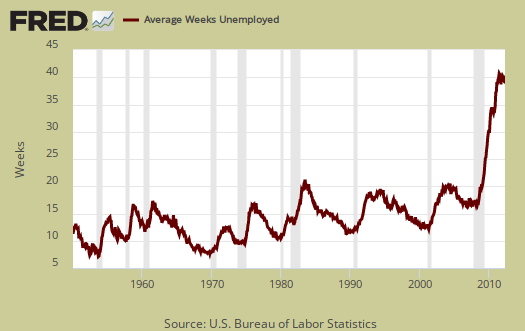
People unemployed for 27 weeks or more also increased, from 41.3% to 42.8% of the total unemployed. That's 5,411,000 people officially counted as unemployed and an increase of 310 thousand from last month. This percentage has barely budged as a percentage of total unemployed and implies people simply run out of unemployment benefits and then just drop out of being even counted as needing a job.

Some people are in part-time jobs because they want to be, others because they cannot find anything else. There are 8.1 million people stuck in part-time jobs because that's all they can get, an uptick of 245 thousand from last month.
Some are stuck in part-time because their hours were cut by their employer. These part-timers due to slack work now number 5,147,000, a decline of 40 thousand from last month. Below is a graph of forced part-time because they got their hours cut as a percentage of the total employed. If you want to see a recession economic indicator, this looks like a pretty damn strong one. See how closely the percentage increase matches recessions, the gray bars? The percentage of people in part-time jobs due to slack economic conditions has stayed extremely high since the start of the Great Recession, even while declining. Take it as an indicator of how much the American worker is still on the edge.

U-6 is a broader measure of unemployment, includes the official unemployed, people stuck in part-time jobs and a subgroup not counted in the labor force but are available for work and looked in the last 12 months. U-6 has also remained consistently high. In May U-6 was 14.8%, up from April's 14.5%.
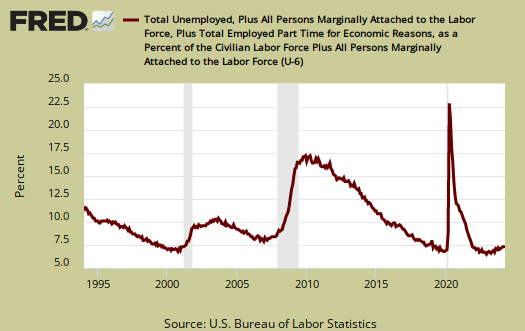
The real number of people wanting a job for April is 27.11 million, over double the official counted as unemployed of 12.72 million. One needs to add up the official unemployed, people stuck in part-time who need full-time jobs, and all of those people not in the labor force, but who report they actually want a job, currently at 6.29 million.
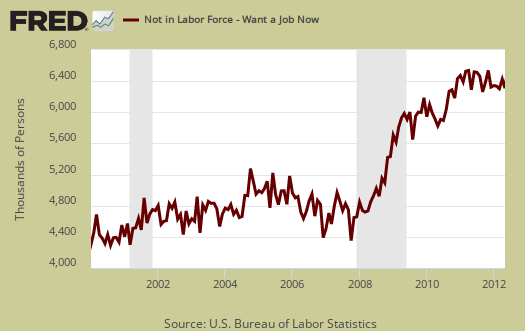
This gives an unemployment rate of 16.81%, calculated following the methods from this article on estimating the real unemployment numbers. April's alternative unemployment rate was 16.62%.
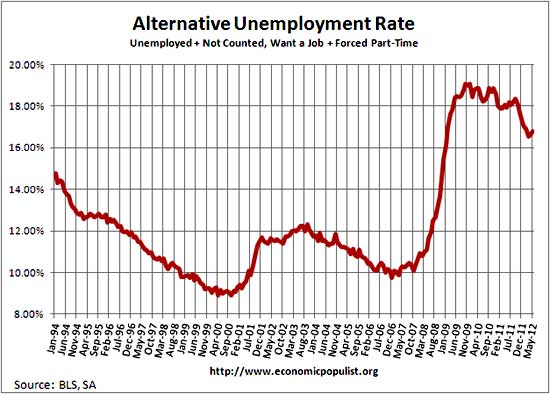
The marginally attached are people not in the labor force because they have not looked for a job in the last month, but have looked for a job in the last year. This number has ballooned since 2007 and not returned to pre-recession levels. The graph below is the number of people considered marginally attached to the labor force, currently at 2.423 million.
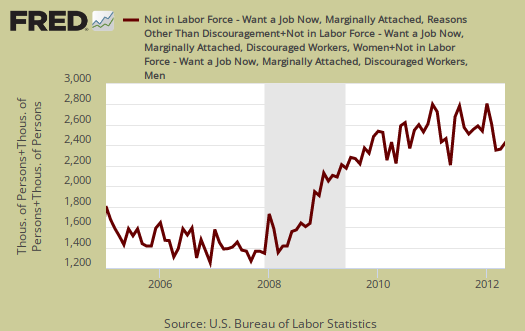
Discouraged workers are people, not counted as part of the civilian labor force, who not only want a job, but also looked for one in the last year. These people aren't job hunting for the last month because they believe there are no jobs out there. Discouraged workers are part of the marginally attached, yet report the reason they didn't look for a job in the last month is they believe there are no jobs out there. Below is the graph of discouraged workers, currently at 830 thousand.
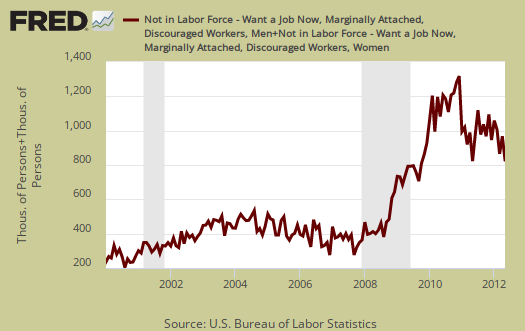
A final area of contention is figuring out how many jobs are needed each month to keep up with population growth. Seems many in the press just throw out a number. We just don't know due to civilian non-institutional population fluctuation. We do know that overall population monthly growth has been hovering around 200,000 a month, this month the change was 182,000. We also know the civilian non-institutional population is roughly 75% of the total population. We also know the labor participation rates and employment to population ratios are artificially low. Therefore, it's safe to say we need about 100,000 jobs per month to keep up with population growth at these same labor participation rates. The Atlanta Fed got sick of the debate it seems and put up a monthly jobs calculator. As we can see payrolls are simply not even keeping up with population growth, never mind rehiring the millions who need work.

Recent comments